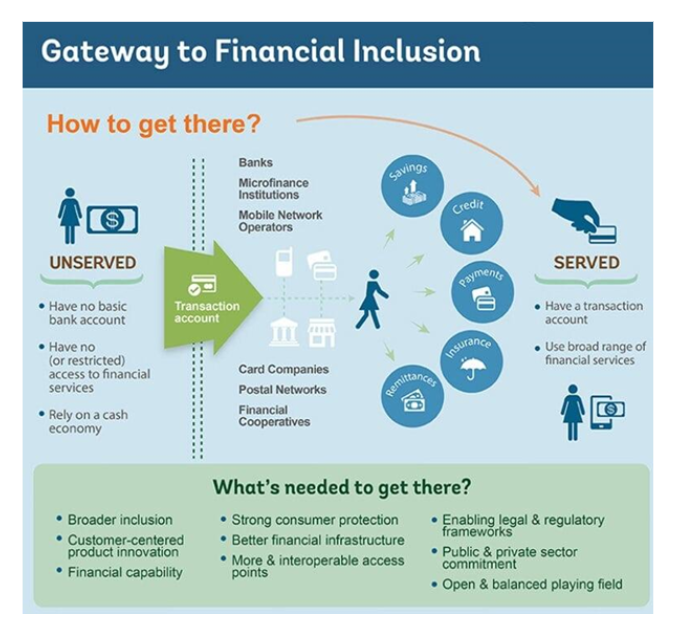Tuesday, 12th September 2023
World Bank on India's Progress DPI
In News: Recently, the World Bank has lauded the transformative impact of DPIs in India over the past decade.
About
Digital Public Infrastructure (DPI) encompasses fundamental building blocks and platforms, such as digital identification, payment infrastructure, and data exchange solutions. These elements play a pivotal role in facilitating a country's ability to provide essential services to its citizens, ultimately fostering empowerment and an enhanced quality of life through digital inclusion.
DPIs serve as the conduits for the seamless movement of three critical components:
- First, they enable the smooth flow of individuals through a robust digital identification system.
- Second, they facilitate the swift transfer of financial resources via a real-time, high-speed payment system.
- Third, they govern the secure and consent-driven exchange of personal information, thereby unlocking the full potential of DPIs and granting citizens genuine control over their data.
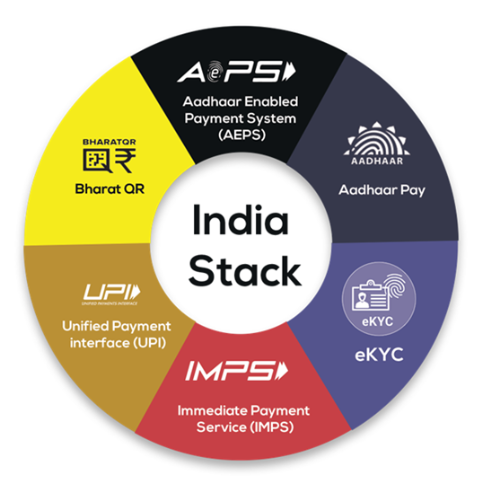
Steps taken by the government in shaping the Digital Public Infrastructure (DPI) landscape:
- Financial Inclusion: The World Bank document notes that India has achieved in just 6 years what would have taken about five decades.
- JAM Trinity has propelled the financial inclusion rate from 25% in 2008 to over 80% of adults in the last 6 years, a journey shortened by up to 47 years thanks to DPIs.
- Since its launch, the number of PMJDY accounts opened tripled from 147.2 million in March 2015 to 462 million by June 2022; women own 56 percent of these accounts, more than 260 million.
- The Jan Dhan Plus program encourages low-income women to save, resulting in over 12 million women customers (as of April 2023) and a 50% increase in average balances in just five months, as against the entire portfolio in the same time period.
- Government to Person (G2P) Payments (World’s largest digital G2P):
- This approach has supported transfers amounting to about $361 billion directly to beneficiaries from 53 central government ministries through 312 key schemes.
- As of March 2022, this had resulted in a total savings of $33 billion, equivalent to nearly 1.14 percent of GDP.
- UPI:
- More than 9.41 billion transactions valuing about Rs 14.89 trillion were transacted in May 2023 alone. For the fiscal year 2022–23, the total value of UPI transactions was nearly 50 percent of India’s nominal GDP.
- DPIs’ Potential Added Value for the Private Sector:
- The DPI in India has also enhanced efficiency for private organizations through reductions in the complexity, cost, and time taken for business operations in India.
- NBFCs have been enabled 8% higher conversion rate in SME lending, a 65% savings in depreciation costs and 66% reduction in costs related to fraud detection.
- According to industry estimates, banks’ costs of onboarding customers in India decreased from $23 to $0.1 with the use of DPI.
- Lower Cost of Compliance for Banks for KYC
- India Stack has digitized and simplified KYC procedures, lowering costs; banks that use e-KYC lowered their cost of compliance from $0.12 to $0.06. The decrease in costs made lower-income clients more attractive to service and generated profits to develop new products.
- Cross-Border Payments:
- The UPI-PayNow interlinking between India and Singapore operationalized in February 2023, aligns with G20's financial inclusion priorities and facilitates faster, cheaper, and more transparent cross-border payments.
- Account Aggregator (AA) Framework:
- India’s Account Aggregator (AA) Framework aims to strengthen India’s data infrastructure, enabling consumers and enterprises to share their data only with their consent through an electronic consent framework. The framework is regulated by RBI.
- Total of 1.13 billion cumulative accounts are enabled for data sharing, with a 13.46 million cumulative number of consents raised in June 2023.
- Data Empowerment and Protection Architecture (DEPA):
- India's DEPA grants individuals control over their data, enabling them to share it across providers. This promotes tailored product and service access without requiring new entrants to invest heavily in pre-existing client relationships, fostering innovation and competition.

G20 Document Prepared by World Bank Lauds India's Progress
African Union in G20 - Edukemy Current Affairs
Why in News: Recently, the African Union (AU) became a new permanent member of the G20 during the 18th G20 Heads of State and Government Summit in New Delhi.
G20 Group:
- The G20 or Group of 20 is an intergovernmental forum comprising 19 sovereign countries, the European Union (EU), and the African Union (AU) (Added in 2023).
- It works to address major issues related to the global economy, such as international financial stability, climate change mitigation and sustainable development.
- It accounts for around 80% of gross world product (GWP), 75% of international trade, two-thirds of the global population, and 60% of the world's land area.
- There is no permanent Secretariat or Headquarters of G20. 19 Countries are divided into 5 groups and the presidency rotates annually between each group.
- Troika is a working association between the current presidency, past presidency and the future presidency.
Key Highlights of G20 Summit 2023:
- The G20 leaders agreed to admit the African Union as a permanent member of the G20. It offers an opportunity to reshape global trade, finance, and investment and would provide a greater voice to the Global South within the G20.
- A Memorandum of Understanding (MoU) was signed between the Governments of India, the US, Saudi Arabia, the European Union, the UAE, France, Germany and Italy to establish the India – Middle East – Europe Economic Corridor (IMEC).
- The World Bank prepared the G20 Global Partnership for Financial Inclusion document in which the transformative impact of India's Digital Public Infrastructure (DPI) over the past decade under the Central Government has been praised. It emphasized various initiatives like JAM Trinity, Pradhan Mantri Jan Dhan Yojana (PMJDY), UPI Dominance, Data Empowerment and Protection Architecture (DEPA), etc.
- G20 countries promised to work towards tripling the global renewable energy capacity by 2030. It aligns with global efforts to limit global warming to 1.5 degrees Celsius.
- The agriculture working group during the G20 Presidency reached a historic consensus on two aspects: Deccan G20 High-level principles on Food Security and Nutrition and the Millet initiative called MAHARISHI.
- India's G-20 presidency has laid the foundation for a coordinated and comprehensive policy and regulatory framework for cryptocurrencies.
- Prime Minister of India handed over the customary gavel of the G20 chair to Brazilian President Luiz Inacio Lula da Silva, who will officially take over the presidency on December 1, 2023.
African Union (AU):
- The African Union (AU) is a continental body consisting of 55 member states in Africa.
- In 1963, the Organization of African Unity (OAU) was founded to promote cooperation among African states.
- In 2002, the OAU was succeeded by the AU with a goal to accelerate economic integration of the continent.
- African Continental Free Trade Area (AfCFTA) was established in 2018 which seeks to create a single continental market for goods and services.
Management of e-waste in India
Why in News: Recently, the Indian Cellular and Electronics Association (ICEA) released a report on ‘Pathways to Circular Economy in Indian Electronics Sector’ in collaboration with NITI Aayog, aiming to explore opportunities for managing electronic waste (e-waste) more effectively.
Key Highlights of the ICEA Report:
- According to the report, e-waste management in India is predominantly informal, with approximately 90% of e-waste collection and 70% of recycling being managed by a competitive informal sector.
- The report emphasizes the need to shift the outlook on e-waste management towards establishing a circular economy. For example, China targets 5% of secondary raw material in new products by 2019 and aims for 35% by 2030.
- The report suggested the following initiatives:
- Establish public-private partnerships for a reverse supply chain
- Create an auditable database of collected materials
- Develop geographical clusters for processing devices
- Incentivize high-yield recycling centres
- Support the right to repair by users
E-wastes in India:
- E-waste refers to all items of electronic and electrical equipment (EEE) and its parts that have been discarded by their owner as waste without the intent of re-use.
- According to the Global E-waste Monitor 2020, India is the third-largest e-waste generator in the world after China and the USA.
- The volume of e-waste in India has witnessed a significant surge to 1.6 million tonnes in 2021-22.
E-waste Management in India:
- At present the management of e-waste is addressed within the framework of the E-Waste (Management) Rules 2022. The key provisions are mentioned below:
- It has increased the range of electronic goods covered e.g., laptops, mobile, cameras etc.
- It has restricted the use of hazardous substances (such as lead, mercury, and cadmium) in manufacturing electrical and electronic equipment that have an adverse impact on human health and the environment.
- Producers of electronic goods have to ensure at least 60% of their electronic waste is collected and recycled by 2023 with targets to increase them to 70% and 80% in 2024 and 2025, respectively.
- ‘Environmental compensation’ to be provided by the companies that don’t meet their target.
- Extended Producer Responsibility Certificates (similar to carbon credit mechanism) will allow the offsetting of e-waste responsibility to a third party.
- The Central Pollution Control Board shall conduct random sampling of electrical and electronic equipment placed on the market to monitor and verify the compliance of reduction of hazardous substances provisions.
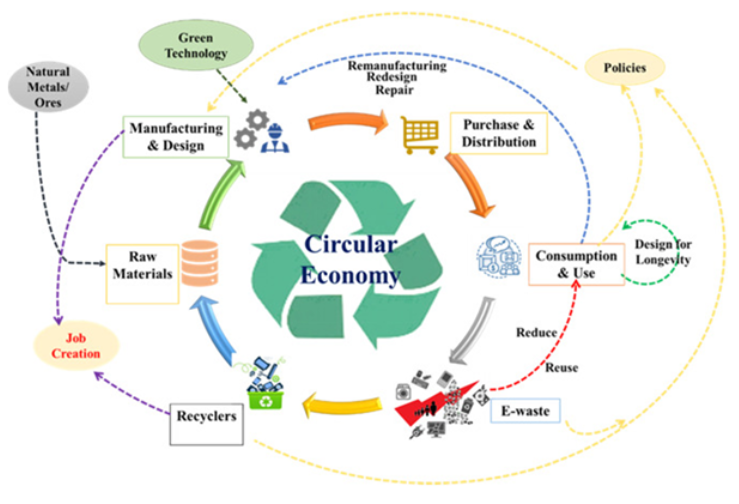 Current Initiatives:
Current Initiatives:
- The Bhopal e-waste clinic is a pilot project in this field. It enables door-to-door collection or direct deposit at the clinic, offering a fee-based exchange.
- ‘Karo Sambhav’, a Delhi-based initiative has integrated informal aggregators in its collection mechanism.
Explained | What should be done with electronic waste? - The Hindu
Tribes India pavilion (G20) - Edukemy Current Affairs
Why in news? Recently, The Tribal Cooperative Marketing Development Federation of India Ltd. (TRIFED), Ministry of Tribal Affairs is showcasing a wide range of traditional tribal art, artifacts, paintings, and many more at the ‘Tribes India’ pavilion as part of the G-20 Leaders’ Summit in New Delhi’s Crafts Bazaar.
About:
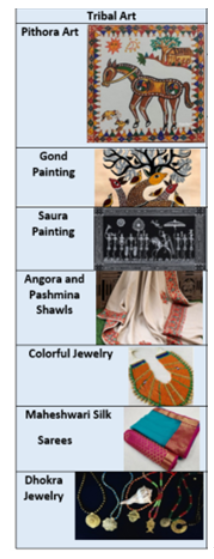
- The Tribes India pavilion at the G-20 Leaders’ Summit in New Delhi showcases a diverse range of tribal arts and crafts, including:
- Pithora Art:
- It is a ritualistic painting characterized by animated figures and lavish use of color.
- These paintings are done by the Rathwa, Bhilala, Naik and Bhil tribes of Gujarat and Madhya Pradesh.
- The paintings speak of the social, cultural and mythological life and beliefs of the tribals.
- The paintings are a medium of propitiation, thanksgiving and commemoration of auspicious occasions.
- Padma Shri awardee Shri Paresh Rathwa is a renowned artist of Pithora art.
- Gond painting from Madhya Pradesh, known for its Intricate and colorful design.
- Saura painting by artisans from Odisha, known for its distinct style.
- Angora and Pashmina shawls from the high altitudes of Leh-Ladakh and Himachal Pradesh, known for its high quality.
- The colorful jewellery by the Konyak tribes of Nagaland appeases the eye.
- Maheshwari silk sarees from Madhya Pradesh: It is worn during religious functions and auspicious events.
- Dhokra jewellery:
- It is carved out of molten metals, beads, colorful glass pieces, and wooden balls.
- Tribal artisans from West Bengal, Odisha, Chhattisgarh and Madhya Pradesh are the architects of these pieces of intrinsic art.
- Pithora Art:
World food price index - Edukemy Current Affairs
Why in news? Food and Agriculture Organization (FAO) reported that the world food price index fell to a new two-year low recently.
About:
- The FAO Food Price Index (FFPI) is a measure of the monthly change in international prices of a basket of food commodities.
- It consists of the average of five commodity group price indices – cereals, oilseeds, dairy products, meat and sugar, weighted by the average export shares of each of the groups over 2014-2016.
- Recent decline reversed a previous month’s rebound, with most food commodities experiencing decreases, although rice and sugar prices.

Self-Regulatory Organisation (SRO) for fintech entities
Why in news? Recently, Reserve Bank of India (RBI) Governor Shaktikanta Das has asked fintech entities to form a Self-Regulatory Organisation (SRO).
About:
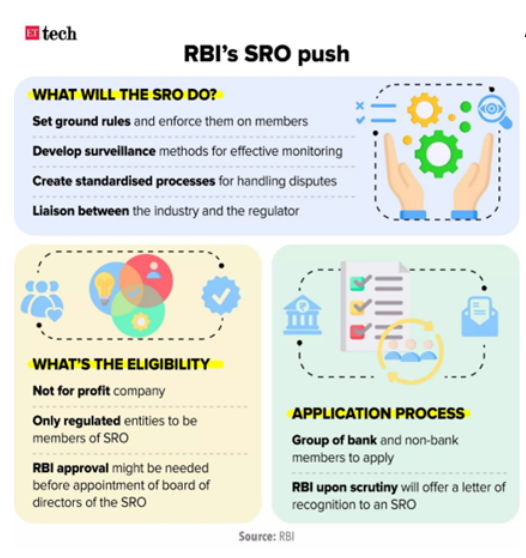
- Fintech, short for “financial technology,” refers to the innovative use of technology to deliver a wide range of financial services and products.
- Fintech companies leverage cutting-edge technology, including software, applications, and digital platforms, to create more efficient, accessible, and user-friendly solutions in the financial industry.
- They often operate in areas such as digital payments, lending, investing, insurance, and wealth management.
- Some examples include mobile banking, peer-to-peer payment services (e.g., Gpay, PhonePe), automated portfolio managers (e.g., Fintoo, Motilal Oswal), or trading platforms (e.g., Zerodha, Groww).
Self-Regulatory Organisation (SRO)
- Self-Regulatory Organisation (SRO) is a non-governmental organization that sets and enforces industry rules to protect customers, and promote ethics, equality, and professionalism.
- Framing of Rules: SROs typically collaborate with all stakeholders in framing rules and regulations.
- Their self-regulatory processes are administered through impartial mechanisms such that members operate in a disciplined environment and accept penal actions by the SRO.
- SRO regulations complement existing laws and regulations.
- Recognition: Reserve Bank of India will be authority of issuing letters of recognition.
Functions of SROs:
- Establishing codes of conduct: To foster transparency, fair competition, and consumer protection.
- Communication Channel: Serve as a link between members and regulatory bodies like the RBI.
- Establishing Standards: Set industry benchmarks and encourage professional conduct.
- Training and Awareness: Provide member training and awareness programs.
- Grievance Redressal: Establish a uniform grievance resolution framework.
- Others: SRO is expected to address concerns such as to protect workers, customers or other participants in the ecosystem.
Advantages of SROs
- SROs are experts in their industries, providing valuable knowledge and insights to their members.
- They enforce ethical standards among their members, fostering trust in the industry.
- SROs act as watchdogs, preventing unprofessional practices.
Hallmarking in India - Edukemy Current Affairs
Why in news? The third phase of the mandatory hallmarking vide Hallmarking of Gold Jewellery and Gold Artefacts (Third Amendment) Order, 2023 comes into force from September 8, 2023.
About:

- It will include an additional 55 districts, making the total number of districts covered under mandatory hallmarking as 343.
Hallmarking
- Hallmarking is like a quality stamp for jewellery and precious metal items.
- Hallmarks are thus official marks used in many countries as a guarantee of the purity or fineness of precious metal articles.
- The principle objectives of the Hallmarking Scheme:
- to protect the public against adulteration
- to obligate manufacturers to maintain legal standards of fineness.
Hallmarking in India:
- At present two precious metals namely gold and silver have been brought under the purview of Hallmarking.
- Mandatory hallmarking order is applicable on 14, 18 and 22 carats of gold jewellery/artefacts only.
- Bureau of Indian Standards (BIS) assigns a unique HUID (Hallmarking Unique ID) number to all hallmarked items.
- HUID is a six-digit alphanumeric code.
- It is given to every piece of jewellery at the time of hallmarking and is unique for each piece.
- The Government has made it mandatory the introduction of a HUID number in every piece of jewellery.
- Consumers can verify the authenticity of hallmarked items using the ‘verify HUID’ feature in the BIS Care app.
- Applicable since: It is applicable for gold since 2000 and for silver since 2005.
Fujianvenator - Edukemy Current Affairs
Why in news? Recently, Scientists in China have uncovered fossils of a peculiar, bird-like dinosaur named Fujianvenator prodigiosus, which lived around 148 to 150 million years ago in southeast China.
About:

- The dinosaur had elongated legs and arms built much like wings, suggesting it either was a fast runner or lived a lifestyle like a modern wading bird.
- Fujianvenator is a member of a grouping called avialans.
- This group includes all birds and their closest non-avian dinosaur.
Features:
- Its forelimb is generally built like a bird's wing, but with three claws on the fingers, which are absent from modern birds.
- Its lower leg bone – the tibia – was twice as long as its thigh bone – the femur.
- It also had a long bony tail.
- It cannot be determined whether it could fly or not.
- Fujianvenator’s discovery contributes to our understanding of the evolutionary history of birds, which evolved from two-legged, feathered dinosaurs known as theropods during the late Jurassic period.
White sambar deer - Edukemy Current Affairs
Why in news? Recently, A rare white sambar deer (leucistic sambar deer) was spotted in a camera trap at Cauvery Wildlife Sanctuary limits, in Chamarajanagar district.
About:
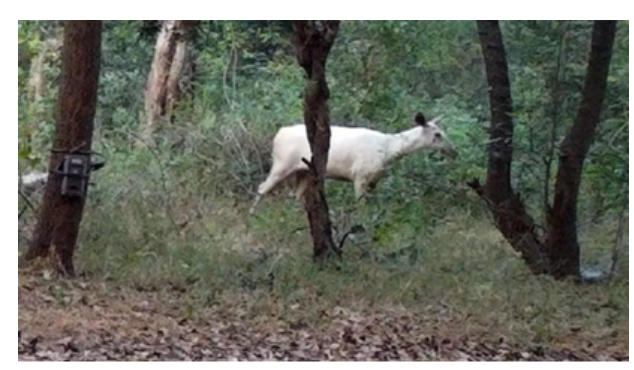
- This is the first time a leucistic sambar deer has been spotted in this forest area. A White Sambar Deer was previously recorded in Bandipur Tiger Reserve in 2014.
- Leucism is a genetic condition that affects the pigmentation of an animal’s skin, feathers, scales, or fur.
- Unlike albinism, which causes a complete absence of pigment, leucism results in a partial loss of pigment, leading to white or pale colouration in affected areas.
Sambar deer:
- The Sambar (Rusa unicolour) is a large deer native to the Indian subcontinent and Southeast Asia.
- They are quite elusive and are most active at dusk and at night.
- They are found in a broad range of forest habitats like dry deciduous forests, rainforests and mixed forests.
- Distribution: Their range is distributed from the foothills of the Himalayan Mountains across southern Asia and reaching the islands of Taiwan, Sumatra and Borneo.
- Conservation status
- IUCN: Vulnerable
- The Wildlife (Protection) Act, 1972: Schedule-III

Ridding India of food insecurity
Exam view: Food insecurity; Failed macroeconomic policy; The significance of the Green Revolution; Initiatives to work on.
Context: Ensuring that Indians have permanent access to a healthy diet is the most important task of economic policy today.
Decoding the editorial: Food insecurity
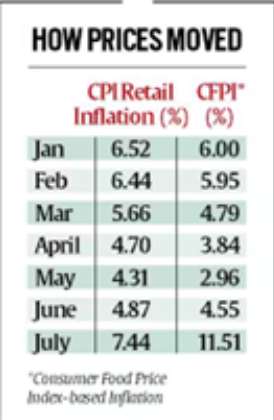
- The ‘State of Food Security and Nutrition in the World’ of the Food and Agriculture Organization (FAO) estimates the figure for India in 2021 is devastating:
- An estimated 74% of the population cannot afford a healthy diet.
- Given a population of 1,400 million, this makes for approximately one billion Indians.
- The trend in the price of food in Mumbai city over 2018-2023 found that while the cost of preparing a thaali at home has risen by 65%, in this period, the average wage of a manual worker rose by 38% and that of a salaried worker by 28%.
- The implied reduction in purchasing power is considerable, and it would be reasonable to expect that food consumption has been impacted.
- The latest National Family Health Survey undertaken over 2019-21 reported a rise in the prevalence of anaemia, mostly induced by nutrient deficiency, which is in line with the above findings.
- This suggests that the FAO’s finding, that over half of India cannot afford a healthy diet, is plausible.

Failed macroeconomic policy
- It relied on controlling inflation, which has proved to be useless in the context.
- The Reserve Bank of India has failed in this task, with the inflation rate mostly higher than the target for four years by now.
- Its approach of contracting output when the inflation rate rises, misleadingly termed “inflation targeting”, does nothing to manage food inflation stemming from the supply side.
- It is necessary to intervene on the supply side to ensure that food is produced at a steady price by raising the yield on land.
The significance of the Green Revolution
- The government engineered a Green Revolution in the 1960s, which orchestrated a supply-side response by providing farmers with high-yielding seeds, cheap credit, and assured prices through procurement.
- Some mistakes were made:
- The rampant use of chemical fertiliser, fuelled by subsidy, which degraded the soil.
- There was also the reliance on procurement prices rather than productivity increase to ensure farm incomes, which fuelled inflation.
- The policy was almost exclusively focused on cereals rather than pulses, the main source of protein for most Indians.
- India should be focused on correcting these mistakes now and lowering the cost of producing food.
- The first Green Revolution had a specific agenda of making India self-sufficient in food.
- A second agricultural revolution is needed now to contain the rising price of food.
- Procurement prices, cash transfers, the Public Distribution System, and priority lending required of public sector banks are not sufficient.
- Yield increasing interventions on the farm are needed to at least contain the cost of production, if not to actually lower it.
Initiatives to work on
- Attention is needed to extend irrigation to 100% of the net sown area.
- Increased public expenditure on irrigation is not reflected in an increase in irrigated area, whether due to waste or the diversion of funds has not been established.
- An end to restrictions on leasing of land.
- The ongoing fragmentation of already small land holdings lowers the capacity for productivity-enhancing capital investment, for which leasing is a solution.
- A quickening of agricultural research.
- India’s network of public agricultural research institutes needs to be energised to resume the sterling role they had played in the 1960s.
- The re-institution of extension.
- Finally, extension has now more or less vanished from where once the gram sevak was a familiar figure in the village, playing a crucial role in the dissemination of best practices. It must be revived.
- Promoting cooperative federalism.
- In the 1960s, the States that were chosen for the spread of the new technology worked closely with the central government.
- This would have to be replicated with the central government taking the States along in a spirit of cooperative federalism.
- At the same time, it may be asked if the States are playing their part to enhance agricultural productivity rather than relying on food allocations to their Public Distribution System from the central pool.
In order to ensure that all Indians have permanent access to a healthy diet, no approach consistent with ecological security must be off the table.
Source:https://www.thehindu.com/opinion/lead/ridding-india-of-food-insecurity/article67296175.ece
Share the article
Edukemy’s Current Affairs Quiz is published with multiple choice questions for UPSC exams
MCQ
Get Latest Updates on Offers, Event dates, and free Mentorship sessions.

Get in touch with our Expert Academic Counsellors 👋
FAQs
UPSC Daily Current Affairs focuses on learning current events on a daily basis. An aspirant needs to study regular and updated information about current events, news, and relevant topics that are important for UPSC aspirants. It covers national and international affairs, government policies, socio-economic issues, science and technology advancements, and more.
UPSC Daily Current Affairs provides aspirants with a concise and comprehensive overview of the latest happenings and developments across various fields. It helps aspirants stay updated with current affairs and provides them with valuable insights and analysis, which are essential for answering questions in the UPSC examinations. It enhances their knowledge, analytical skills, and ability to connect current affairs with the UPSC syllabus.
UPSC Daily Current Affairs covers a wide range of topics, including politics, economics, science and technology, environment, social issues, governance, international relations, and more. It offers news summaries, in-depth analyses, editorials, opinion pieces, and relevant study materials. It also provides practice questions and quizzes to help aspirants test their understanding of current affairs.
Edukemy's UPSC Daily Current Affairs can be accessed through:
- UPSC Daily Current Affairs can be accessed through Current Affairs tab at the top of the Main Page of Edukemy.
- Edukemy Mobile app: The Daily Current Affairs can also be access through Edukemy Mobile App.
- Social media: Follow Edukemy’s official social media accounts or pages that provide UPSC Daily Current Affairs updates, including Facebook, Twitter, or Telegram channels.

